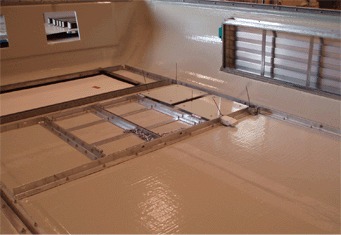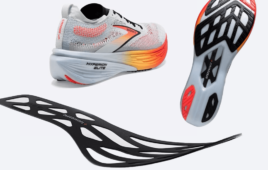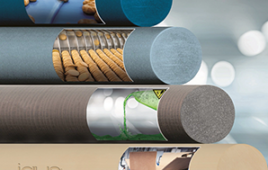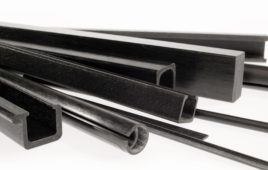Environmental concern is certainly one trend influencing design choice, but another trend is cost. With oil prices fluctuating daily, material suppliers are working to reduce petroleum content.
One of the largest users of such materials is the packaging industry. According to the CEO of Octal Holding SAOC, a manufacturer of APET sheet and PET resin, three new material trends will have a lasting affect on this industry.
–Packaging materials will need to be simultaneously transparent and protective.
–New materials are needed to enable flexible packaging displays; merchandisers need the ability to arrange a product display in multiple ways, such as on hooks, on a shelf stack, multi-packed, or in trays.
–For production speed and efficiency, the focus is now on selecting the best single packaging material for the product and developing the ideal packaging from that one material.
And, of course, the trend to eliminate excess material in packaging remains. Apple Inc., for example, continues its program of material reduction and replacement. The packaging for the iPod classic now consumes 32% less weight and 82% less volume than the first generation. With each generation of the iMac, Apple engineers have increased material efficiency, decreased packaging mass and volume, and decreased energy consumption. Packaging for the current generation 20-in. iMac uses 66% less plastic and 42% less paper than the 20-in. iMac G4 flat panel, while taking up 41% less space.
As for recycling, Apple plans to completely eliminate the use of PVC in its products by the end of this year and has already eliminated PVC in all plastic parts weighing more than 25 grams, with the exception of cable enclosures.
Recycling products made of plastic is neither easy nor profitable yet. When a product contains many different types of plastics, there is often little motivation to recycle. A cell phone, for example, can contain dozens of different types and colors of plastic. The resources needed to separate each plastic and properly dispose of it would easily exceed its value.
Thus, research is ongoing to develop easier and profitable recycling methods. One area of research is in biodegradable plastics. Scientists are exploring the use of sunlight, water, bacteria, enzymes, wind abrasion and rodent pest or insect attack as possible forms of biodegradation. Biopol is an example of one plastic that a specially designed bacteria degrades. Ecoflex, from BASF, is a biodegradable polyester for use in food packaging applications. Drawbacks such as the release of greenhouse gases like carbon dioxide still need to be overcome.
Even so, materials that meet the newer needs of recyclability, safe degradability, and others are emerging. Here is a look at a few recent introductions.

The copolyester, Tritan™, from Eastman Chemical Co., offers clarity and chemical resistance, as well as high heat resistance and improved flexibility.
New copolyester increases design freedom
A new-generation copolyester, Tritan™, from Eastman Chemical Co., delivers the advantages of traditional copolyesters, such as clarity and chemical resistance, but with higher heat resistance and improved flexibility. It is easier to process, and is free of the potentially toxic chemical bisphenol-A (BPA).
“We anticipate continued annual growth of 6 to 8% for the global copolyester market,” said Dante
Rutstrom, vice president and general manager of Eastman’s specialty plastics business.
The material suits a range of applications from housewares and appliances to extruded-sheet applications. CamelBak® water bottles and Vita-Mix® premium blenders are made from the material.
Cool Gear International Inc. is another company that uses the material in its line of reusable water bottles. The company recently partnered with Eastman to introduce the EZ FREEZE FREE™ line of beverage bottles manufactured with Tritan™. The material is suitable for food and beverage containers because of its dishwasher durability and design flexibility.
The flexibility lets Cool Gear engineers combine unique shapes and colors in their designs and meet consumer demands for clear, durable bottles. Previous designs used polycarbonate material. In addition to the chemical resistance and low residual stress associated with traditional copolyesters, Tritan™ resists higher temperatures, enabling product to undergo numerous dishwater washings without crazing, cracking or hazing from continual exposure to high heat and aggressive cleaning detergents. Dishwasher durability is an important differentiator for plastic products.
Additionally, Tritan™ can be manufactured in molds designed for polycarbonate. The EZ FREEZE FREE product line was produced with polycarbonate in the past, so the shift to Tritan™ with the same molds made the process seamless.
From material to material systems
A Material System is a combination of values and properties of individual materials that combined make what, in essence, is a new material. According to McClarin Plastics, material systems are a product of creativity. While not unique to the company, the concept is not common. Most processors and designers tend to focus on one process or material in component development.
A material system is typically a thermoset plastic core sandwiched between an outer skin.

A Material System is a combination of properties of individual materials that combined make a new material. This example material system is 34 by 8 feet.
In McClarin’s system, the core material provides insulation and sound reduction. The thermoset plastics can also be combined with metal when a design requires. In some applications, it can replace steel, aluminum, and fiberglass.

The semiconductor test socket machined from Quadrant EPP Semitron® MDS 100 shows the detail that can be maintained even in the most unstable application environments.
One benefit is cost reduction. A more expensive part or material, such as steel, is used only where needed, and often in smaller quantities. Metal is still used in the component for structural purposes, but any unnecessary metal is replaced with thermoset plastics.
Another benefit is the opportunity to take out weight. A component made of this material can weigh 1/6 to 1/8 that of a solid metal component. Other benefits include impact resistance; the ability to reuse as thermoplastics and metal are recyclable; and ease of repair when compared to metal or fiberglass materials.
One area of caution involves the fastening of system components. Adhesives are preferred but require close evaluation and testing to assure the integrity of the system structure.
Better tolerances
If you work with equipment that requires precise, reliable tolerances, Quadrant’s Semitron® MDS 100 machining stock is a strong, stiff material. It is suitable for test sockets in semiconductor test and package equipment, for fixtures for electronics testing, for mounting points for precision diagnostic equipment, and for positioning platforms for miniature motion control devices.
Its flexural modulus (ASTM D790) is in excess of 1,400,000 psi, with low moisture absorption (24 hr., ASTM D570) of 0.10%. Its low coefficient of linear thermal expansion (ASTM E831) of 1.1 x 10-5 contributes to its stability. The heat deflection or softening temperature is 410° F (210° C)
Thermally conductive polymer
As devices and products shrink in size, the need to manage or dissipate heat increases. Newly formulated grades of CoolPoly® thermally conductive polymers from Cool Polymers, Inc. remove excess heat from wound coils, molded bobbins and other wound devices such as solenoids, ignition and clutch coils, surface mount coils, and transformers. They can be an alternative to metal materials.

Newly formulated grades of CoolPoly® thermally conductive polymers from Cool Polymers, Inc., provide an efficient heat conduction path to other components in contact with bobbins.
Coil windings have a tendency to rise in temperature during operation. Bobbins made from conventional polymers are thermal insulators with heat dissipated only by convection at the outer surface of the winding. The Cool Polymers provide an efficient heat conduction path to other components (most likely metallic) in contact with the bobbin.
The injection moldable polymers withstand heat to 280° C (536° F). They can reduce surface and part temperature, which will increase device lifetime.

eXasis the drivable “glass” car: the third concept car developed by Rinspeed and Bayer MaterialScience AG.
Thermal grease keeps chips cool
The COOLSPAN™ Thermal Interface Materials (TIM), from Rogers Corp., are thermally conductive non-silicone thermal greases. Features include thermal stability, ability to handle high temperatures, high thermal conductivity, and good demateability properties to silicone products.
The material is used in chip packaging applications where heat management is critical. It can be used in both TIM-1 and TIM-2 applications.
The material is environmentally benign, halogen free, and does not contain any of the hazardous substances listed in the Restriction of Hazardous Substances Directive (RoHS) in a concentration exceeding the standard.

For chip packaging applications, Rogers Corp. offers the COOLSPAN™ line of thermal interface materials. These materials are thermally conductive non-silicone thermal greases.
Since 2004, Rogers’ Technology Development Group has grown its research and development activities in greener technologies. New product formulations have been created based on renewable or recycled materials; materials that contain no plasticizers, PVC, halogens or heavy metals; and VOC free materials that are low outgassing and low fogging.
Environmentally friendly thin film
Several electronics manufacturers are voluntarily reducing halogenated additives in their products. The new thermoplastic film, EFR 735, from SABIC Innovative Plastics is made without the use of brominated or chlorinated flame-retardants. It also supports the cost-reducing trend toward smaller, thinner devices with its very thin gauges that can be as little as 0.006 in.
The film is a candidate for shielding and insulation barriers, printed circuits, die-cut spacers and insulators, labels, and overlays. It is suitable for computers, laptops, mobile phones, portable devices, battery packs, DVD players, printers, appliances, audio/video equipment, and other electrical and electronics applications.
The material delivers VTM-0 flame resistance down to 152 microns without the use of potentially harmful halogenated additives. It has triple the puncture resistance of FRPP and surpasses FRPP in tensile strength. It also offers a higher glass transition temperature (340°C vs. 265°C).
U.S. and European agencies continue to tighten regulations on EMI/RFI emissions. Effective shielding options like metal boxes, conductive paints, plating, metal chassis and conductive polymers, can add cost or weight to electronic devices. Laminated to a conductive foil, such as copper or aluminum, EFR 735 film lets you design shields for placement in close proximity to the emitting source without fear of internal arcing.
EFR 735 film can undergo thermoforming, embossing, clean-edge die cutting, scoring and bending. The product, in a matte/velvet finish, is available in 0.006 in., 0.010 in., 0.017 in., and 0.025 in. gauges.
Companies mentioned in this article:
Autodesk
www.autodesk.com
Cool Polymers, Inc.
www.coolpolymers.com
Eastman Chemical Co.
www.eastman.com
McClarin Plastics Inc.
www.mcclarinplastics.com
Quadrant EPP
www.quadrantplastics.com
Rogers Corp.
www.rogerscorporation.com
SABIC Innovative Plastics
www.sabic-ip.com
Solidworks Inc.
www.solidworks.com
For a list of recyclable materials, you can check out:
http://www.co.contra-costa.ca.us/depart/cd/recycle/options/all.htm
Material Selection aids
Autodesk recently introduced Sustainable Materials Assistant, an add-in database for its Inventor CAD program. It helps organize and tack material information.
You enter data, such as strength, elasticity, texture, as well as such information as toxicity, recyclability, and regulatory parameters into fields you create in the program. Then, in your design you can run the materials sustainability function to see the effect of one material over another. It will indicate how much of any material is in a design. If you use a different material, it will show how the change will affect the carbon footprint or recyclability.

Solidworks also offers a materials database built in to its CAD software. It can feed the analysis, design, and appearance functions. You can enter various types of information, including structural parameters for an FEA or conductivity analysis, as well as color and texture information for accurate rendering.
In the design process, you click on the materials tab from the command line and make a selection. Because the database is integrated into the CAD software, you can check material properties for appearance, physical and thermal properties, and so on.
You may also choose to purchase PDMWorks Enterprise, which will, for example, let you search all the parts of a design that are made of a specific material.
::Design World::
Filed Under: Materials • advanced, Packaging





Tell Us What You Think!